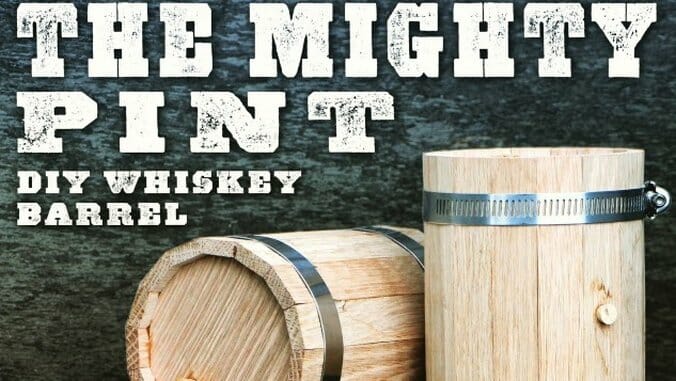Mighty Pint: The Age-Your Own Spirit Mini-Barrel

There are a whole lot of craft beer fans out there today who have a generally poor understanding of the difference between “craft” in the beer market and “craft” in the liquor market.
In the beer market, there’s a very decent chance at any given time that the best beers in the world are being made by very, very small craft brewers—guys making beer on farms, in garages, etc. The reason for this is a matter of resources: A dedicated homebrewer or small-scale professional brewer can conceivably have access to the same level of ingredients and equipment as large-scale regional breweries, and may even use higher-quality ingredients because they can afford to buy them in small amounts. Also: Beer is fast to make, compared to other alcoholic beverages. You can brew a beer one weekend and be drinking it three weeks later.
Not so, in the liquor market, and ESPECIALLY in the ultra-popular market for American whiskey. Whiskey, by its nature, is a time-consuming thing to make. At the very least, we’re talking the better part of a year in a newly charred American oak barrel. To call it “straight” whiskey, you’re looking at a minimum of two years. And even a flagship, “value” whiskey that many drinkers would think of as “cheap stuff”—let’s say Jim Beam white label—is aged even longer, at FOUR years. This is a massive time investment.
The best whiskeys, therefore, tend to come not from the little craft microdistilleries that have popped up in your backyard in the last few years, because they simply haven’t been in business long enough to be competitive in terms of barrel science and the distiller’s art. Innovation, likewise, has mostly been pushed forward by the big, older distilleries, because they’re the ones with the budget, the time and the resources to make it happen.
Is it any surprise, then, that the young distillers are often searching for shortcuts that can allow them to be more competitive and offer a comparable product? And indeed, many young distilleries have found a solution of sorts in the science of barrel surface area. By using either smaller barrels, or barrels with honeycomb patterns and various other internal modifications, they can increase the amount of wood in contact with their distilled spirit. The logic is that this process thus helps the spirit take on the flavor and appearance of “aged whiskey” more rapidly. The point of argument, meanwhile, is obvious: Does aging a spirit FAST infuse comparable flavors to aging a spirit SLOW? New distillers tend to say yes. Old distillers tend to say no. Regardless, the young distilleries are why you see so much white whiskey on liquor shelves these days, because they’re trying to make some kind of revenue while waiting on aged whiskeys to be ready.
This is also the philosophy behind a new Kickstarter product now hitting the market, called The Mighty Pint. A “DIY whiskey barrel” with a volume of roughly a pint, it is meant for the aging of white whiskey or moonshine, but can also be used for barrel-aged cocktails, wines and other potential drinks. The project’s videos and advertising claim to be able to take relatively inexpensive white whiskey and turn it into a “premium” product in as little as a week. And so, we thought we would take a Mighty Pint for a spin and see how our own home-aged whiskey would fare.
Construction
It’s very significant to note that the Mighty Pint does not come assembled, arriving as a pile of newly charred wooden staves with a couple of end caps and metal bands to tighten around them as you construct your mini-barrel. It’s understandable why the vendors don’t want to have to assemble them, as the process is slow and hands-on, ultimately taking multiple days (more on that in a moment). However, it does leave the consumer with a very real chance of completely screwing up the job.
The above video makes assembly look like a breeze, but things didn’t go nearly as smoothly for me. No matter what I did, the first several times I attempted the above method, I was left with significant gaps between the staves that made it quite clear the mini-barrel wouldn’t be holding liquid anytime soon. It didn’t help that my Mighty Pint (this was sent for review purposes, not an order) did not include either the funnel or a set of instructions, which had not yet been printed. A much more detailed video on constructing the mini-barrel is now available from the manufacturer, and this one gives a much better impression of how touchy and precise this process needs to be. When I finally managed to get it together without visible gaps between the staves, it felt more like a matter of luck than anything. The video below even notes that the barrels unsurprisingly vary in small ways in their dimensions, so your Mighty Pint may be easier or harder to assemble than mine. It also recommends sanding the edges of the barrel caps, which was never recommended to me.
-

-

-

-

-

-

-

-

-

-

-

-

-

-

-

-

-

-

-

-

-

-

-

-

-

-

-

-

-

-

-

-

-

-

-

-

-

-

-

-









































